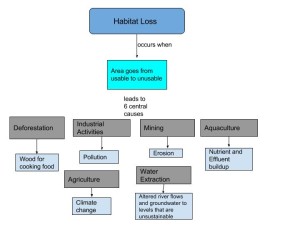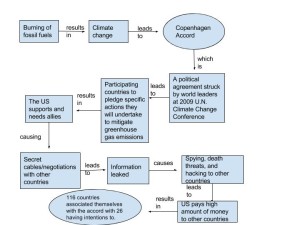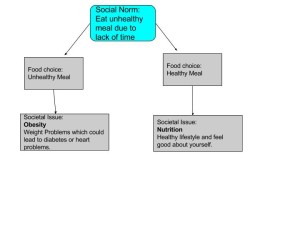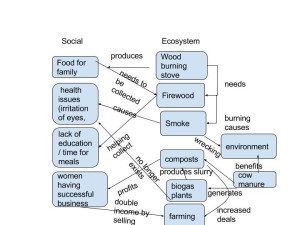- In Module 10, we’ve read about how there are many threats to biodiversity today. The biggest threats can be remembered by using the acronym H.I.P.P.O. Draw a system diagram showing how one of the effects can be a danger to biodiversity. Make sure to include at least 5 components.
- In 215-350 words, define what H.I.P.P.O stands for. After defining H.I.P.P.0., use the biodiversity threats that have been defined and compare them to your hometown. Make sure to use your hometown and not State College.
- In 215-350 words, draw on concepts from this module to determine what you can do to decrease the loss of biodiversity in your hometown.
System Diagram:
The acronym H.I.P.P.O. stands for Habitat Loss, Invasive Species, Pollution, Human Population, and Overharvesting. Habitat loss occurs when a particular area is converted from usable to unusable. An example of habitat loss is deforestation and mining. Pottsville, PA can relate to several of these topics within H.I.P.P.O. Pottsville is known for its coal mining. Pottsville also has strip mining. Strip mining is where they dig massive holes in the ground to extract coal which destroys vegetation and changes natural flow of water from the ground. Strip mining also pollutes drinking water from sulfur. Another example of habitat loss in my hometown is deforestation. My hometown is surrounded by woodlands. Near my house, landowners hired contractors to cut down several miles of trees to sell the trees for lumber. This leads to deforestation and now there is no vegetation on the land. This results in soil erosion which contaminates our streams and creeks with muddy water. This in turn, kills of wild life that depends on the stream clean oxygenated water. Pollution is the discharge of toxic synthetic chemicals and heavy metals into the environment which has a huge impact on species abundance and can lead to extinctions. Pottsville has also contributed to pollution. Back in the days, abandoned mine shafts from deep mining have turned into hazardous waste illegal dump sites. These illegal dumping sites were polluting the water.
In my hometown, there are several ways we can decrease the loss of biodiversity. We are creating more problems that lead to climate change such as deforestation, loss of environment, and pollution. The first thing we can do to decrease loss of biodiversity is use natural resources or renewable energy. By doing this, we won’t be strip mining and creating large holes where we kill off trees. This will then lead to less water pollution because we’re not destroying the natural flow of underground springs and rivers. Also, we won’t be mixing sulfur into the underground springs. Instead of using coal or fuel oil (which pollutes the air), people can use natural gas or windmills. Another way to stop polluting in my hometown is to cut back on using pesticides and fertilizers in lawn care. For example, if birds pick worms out of the ground, the worm is already contaminated with pesticides which will then kill the bird or won’t allow it to reproduce. There are a few ways to cut back on deforestation. Now there are laws that prohibit clear cutting of land and we use selective cutting to cut down certain trees with certain sizes for lumber. This leads to less erosion and contaminates being dispersed into our rivers. Another way to decrease loss of biodiversity is to recycle more often. The more we recycle the less of wastes that go into the landfill. My family doesn’t recycle as much as we should.




